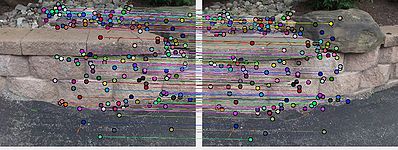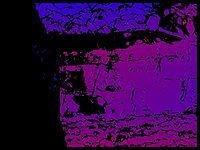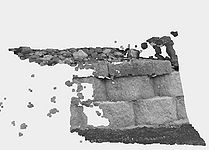Example Stereo Single Camera
From BoofCV
Jump to navigationJump to searchDense Stereo from Single Camera Example
| Associated inlier features between two views | |
|---|---|
| Stereo disparity image | 3D point cloud |
A dense point cloud of an environment can be created from a single camera using two views. If the distance between the two views is not known, then the scale of the found point cloud will be arbitrary. In this example natural features are used to determine the geometric relationship between the two views. The algorithm can be summarized as follows:
- Load camera calibration and two images
- Detect, describe, and associate image features
- Compute camera motion (Essential matrix)
- Rectify image pair
- Compute dense stereo disparity
- Convert into 3D point cloud
Example File: ExampleImageStitching.java
Concepts:
- Point feature association
- Epipolar geometry
- Rectification
- Dense stereo processing
Relevant Applets:
Related Tutorials/Example Code:
Example Code
/**
* Example demonstrating how to use to images taken from a single calibrated camera to create a stereo disparity image,
* from which a dense 3D point cloud of the scene can be computed. For this technique to work the camera's motion
* needs to be approximately tangential to the direction the camera is pointing. The code below assumes that the first
* image is to the left of the second image.
*
* @author Peter Abeles
*/
public class ExampleStereoTwoViewsOneCamera {
// Disparity calculation parameters
private static int minDisparity = 30;
private static int maxDisparity = 160;
public static void main(String args[]) {
// specify location of images and calibration
String calibDir = "../data/applet/calibration/mono/Sony_DSC-HX5V_Chess/";
String imageDir = "../data/applet/stereo/";
// Camera parameters
IntrinsicParameters intrinsic = BoofMiscOps.loadXML(calibDir + "intrinsic.xml");
// Input images from the camera moving left to right
BufferedImage origLeft = UtilImageIO.loadImage(imageDir + "mono_wall_01.jpg");
// BufferedImage origRight = UtilImageIO.loadImage(imageDir+"mono_wall_02.jpg");
BufferedImage origRight = UtilImageIO.loadImage(imageDir + "mono_wall_03.jpg");
// Input images with lens distortion
ImageUInt8 distortedLeft = ConvertBufferedImage.convertFrom(origLeft, (ImageUInt8) null);
ImageUInt8 distortedRight = ConvertBufferedImage.convertFrom(origRight, (ImageUInt8) null);
// matched features between the two images
List<AssociatedPair> matchedFeatures = ExampleFundamentalMatrix.computeMatches(origLeft, origRight);
// convert from pixel coordinates into normalized image coordinates
List<AssociatedPair> matchedCalibrated = convertToNormalizedCoordinates(matchedFeatures, intrinsic);
// Robustly estimate camera motion
List<AssociatedPair> inliers = new ArrayList<AssociatedPair>();
Se3_F64 leftToRight = estimateCameraMotion(intrinsic, matchedCalibrated, inliers);
drawInliers(origLeft, origRight, intrinsic, inliers);
// Rectify and remove lens distortion for stereo processing
DenseMatrix64F rectifiedK = new DenseMatrix64F(3, 3);
ImageUInt8 rectifiedLeft = new ImageUInt8(distortedLeft.width, distortedLeft.height);
ImageUInt8 rectifiedRight = new ImageUInt8(distortedLeft.width, distortedLeft.height);
rectifyImages(distortedLeft, distortedRight, leftToRight, intrinsic, rectifiedLeft, rectifiedRight, rectifiedK);
// compute disparity
StereoDisparity<ImageUInt8, ImageFloat32> disparityAlg =
FactoryStereoDisparity.regionSubpixelWta(DisparityAlgorithms.RECT_FIVE,
minDisparity, maxDisparity, 5, 5, 20, 1, 0.1, ImageUInt8.class);
// process and return the results
disparityAlg.process(rectifiedLeft, rectifiedRight);
ImageFloat32 disparity = disparityAlg.getDisparity();
// show results
BufferedImage visualized = VisualizeImageData.disparity(disparity, null, minDisparity, maxDisparity, 0);
BufferedImage outLeft = ConvertBufferedImage.convertTo(rectifiedLeft, null);
BufferedImage outRight = ConvertBufferedImage.convertTo(rectifiedRight, null);
ShowImages.showWindow(new RectifiedPairPanel(true, outLeft, outRight), "Rectification");
ShowImages.showWindow(visualized, "Disparity");
showPointCloud(disparity, outLeft, leftToRight, rectifiedK, minDisparity, maxDisparity);
System.out.println("Total found " + matchedCalibrated.size());
System.out.println("Total Inliers " + inliers.size());
}
/**
* Estimates the camera motion robustly using RANSAC and a set of associated points.
*
* @param intrinsic Intrinsic camera parameters
* @param matchedNorm set of matched point features in normalized image coordinates
* @param inliers OUTPUT: Set of inlier features from RANSAC
* @return Found camera motion. Note translation has an arbitrary scale
*/
public static Se3_F64 estimateCameraMotion(IntrinsicParameters intrinsic,
List<AssociatedPair> matchedNorm, List<AssociatedPair> inliers)
{
Estimate1ofEpipolar essentialAlg = FactoryMultiView.computeFundamental_1(EnumEpipolar.ESSENTIAL_5_NISTER, 5);
TriangulateTwoViewsCalibrated triangulate = FactoryTriangulate.twoGeometric();
ModelGenerator<Se3_F64, AssociatedPair> generateEpipolarMotion =
new Se3FromEssentialGenerator(essentialAlg, triangulate);
DistanceFromModel<Se3_F64, AssociatedPair> distanceSe3 =
new DistanceSe3SymmetricSq(triangulate,
intrinsic.fx, intrinsic.fy, intrinsic.skew,
intrinsic.fx, intrinsic.fy, intrinsic.skew);
// 1/2 a pixel tolerance for RANSAC inliers
double ransacTOL = 0.5 * 0.5 * 2.0;
ModelMatcher<Se3_F64, AssociatedPair> epipolarMotion =
new Ransac<Se3_F64, AssociatedPair>(2323, generateEpipolarMotion, distanceSe3,
200, ransacTOL);
if (!epipolarMotion.process(matchedNorm))
throw new RuntimeException("Motion estimation failed");
// save inlier set for debugging purposes
inliers.addAll(epipolarMotion.getMatchSet());
return epipolarMotion.getModel();
}
/**
* Convert a set of associated point features from pixel coordinates into normalized image coordinates.
*/
public static List<AssociatedPair> convertToNormalizedCoordinates(List<AssociatedPair> matchedFeatures, IntrinsicParameters intrinsic) {
PointTransform_F64 tran = LensDistortionOps.transformRadialToNorm_F64(intrinsic);
List<AssociatedPair> calibratedFeatures = new ArrayList<AssociatedPair>();
for (AssociatedPair p : matchedFeatures) {
AssociatedPair c = new AssociatedPair();
tran.compute(p.p1.x, p.p1.y, c.p1);
tran.compute(p.p2.x, p.p2.y, c.p2);
calibratedFeatures.add(c);
}
return calibratedFeatures;
}
/**
* Remove lens distortion and rectify stereo images
*
* @param distortedLeft Input distorted image from left camera.
* @param distortedRight Input distorted image from right camera.
* @param leftToRight Camera motion from left to right
* @param intrinsic Intrinsic camera parameters
* @param rectifiedLeft Output rectified image for left camera.
* @param rectifiedRight Output rectified image for right camera.
* @param rectifiedK Output camera calibration matrix for rectified camera
*/
public static void rectifyImages(ImageUInt8 distortedLeft,
ImageUInt8 distortedRight,
Se3_F64 leftToRight,
IntrinsicParameters intrinsic,
ImageUInt8 rectifiedLeft,
ImageUInt8 rectifiedRight,
DenseMatrix64F rectifiedK) {
RectifyCalibrated rectifyAlg = RectifyImageOps.createCalibrated();
// original camera calibration matrices
DenseMatrix64F K = PerspectiveOps.calibrationMatrix(intrinsic, null);
rectifyAlg.process(K, new Se3_F64(), K, leftToRight);
// rectification matrix for each image
DenseMatrix64F rect1 = rectifyAlg.getRect1();
DenseMatrix64F rect2 = rectifyAlg.getRect2();
// New calibration matrix,
rectifiedK.set(rectifyAlg.getCalibrationMatrix());
// Adjust the rectification to make the view area more useful
RectifyImageOps.allInsideLeft(intrinsic, rect1, rect2, rectifiedK);
// undistorted and rectify images
ImageDistort<ImageUInt8> distortLeft =
RectifyImageOps.rectifyImage(intrinsic, rect1, ImageUInt8.class);
ImageDistort<ImageUInt8> distortRight =
RectifyImageOps.rectifyImage(intrinsic, rect2, ImageUInt8.class);
distortLeft.apply(distortedLeft, rectifiedLeft);
distortRight.apply(distortedRight, rectifiedRight);
}
/**
* Draw inliers for debugging purposes. Need to convert from normalized to pixel coordinates.
*/
public static void drawInliers(BufferedImage left, BufferedImage right, IntrinsicParameters intrinsic,
List<AssociatedPair> normalized) {
PointTransform_F64 tran = LensDistortionOps.transformNormToRadial_F64(intrinsic);
List<AssociatedPair> pixels = new ArrayList<AssociatedPair>();
for (AssociatedPair n : normalized) {
AssociatedPair p = new AssociatedPair();
tran.compute(n.p1.x, n.p1.y, p.p1);
tran.compute(n.p2.x, n.p2.y, p.p2);
pixels.add(p);
}
// display the results
AssociationPanel panel = new AssociationPanel(20);
panel.setAssociation(pixels);
panel.setImages(left, right);
ShowImages.showWindow(panel, "Inlier Features");
}
/**
* Show results as a point cloud
*/
public static void showPointCloud(ImageSingleBand disparity, BufferedImage left,
Se3_F64 motion, DenseMatrix64F rectR ,
int minDisparity, int maxDisparity) {
PointCloudTiltPanel gui = new PointCloudTiltPanel();
double baseline = motion.getT().norm();
gui.configure(baseline, rectR, minDisparity, maxDisparity);
gui.process(disparity, left);
gui.setPreferredSize(new Dimension(left.getWidth(), left.getHeight()));
ShowImages.showWindow(gui, "Point Cloud");
}
}


